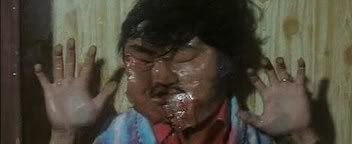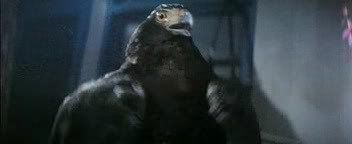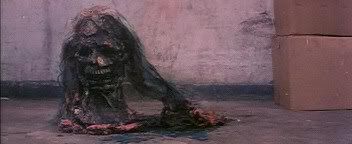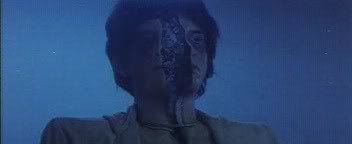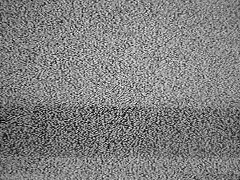
Wednesday, April 22, 2009
Kanashimi no Beradona (1973)
Belladonna, literally "Belladonna of Sadness," also known as "The Tragedy of Belladonna" is an art house animation feature film produced by Mushi Production. Directed and co-written by Eiichi Yamamoto and inspired by Jules Michelet's non-fiction book Satanism and Witchcraft, it is the third and final film in the Animerama trilogy and the only one to be neither written nor directed by Osamu Tezuka (he left Mushi Production during the film's early stages to concentrate on his comics and his conceptual-stage contribution is uncredited). Belladonna is also of a more serious tone than the more comedic first two Animerama films. Its visuals consist mostly of still paintings panned across and are strongly influenced by western art, particularly Aubrey Beardsley, Gustav Klimt and classic tarot illustrations. The film was a commercial failure and contributed to Mushi Pro becoming bankrupt by the end of the year.
It follows the story of Jeanne, a peasant woman who is raped which leads to her being accused of witchcraft, and is notable for its graphic and suggestively erotic, violent and psychedelic imagery.
Download links: 1 2 3 4 5 6 7 8 or 1 2 3 4 5 6 7 8
Tuesday, April 21, 2009
Alice in Acidland (1968)
Cute and perky college student Alice and her cute and perky friend Kathy are invited to a "pool party" by Freida, a female teacher who is actually a lesbian and has designs on Alice. At the party Alice gets drunk, takes acid and immediately becomes a lesbian, taking a bath with Freida. Later Alice gets mixed up with LSD-addicted hippies, rape, more lesbians, more LSD, orgies, suicide, and having sex with guys who keep their boxer shorts on while doing it.
Download links: 1 2 3 4 5 vidcaps
Blowup (1966)
 Blowup is a british-Italian art film directed by Michelangelo Antonioni and was that director's first English language film. It tells the story of a photographer's involvement with a murder case. The film was inspired by the short story "Las Babas del Diablo" ("The Droolings of the Devil") by Argentinian writer Julio Cortázar, and by the work, habits, and mannerisms of Swinging London photographer David Bailey. The film was scored by jazz pianist Herbie Hancock, although the music is mimetic as it is played on a record by the main character. Nominated for several awards at the Cannes Film Festival, Blowup won the Grand Prix. Blow-Up view of the world of mod fashion, and an engaging, provocative murder mystery that examines the existential nature of reality through photography. Antonioni's first film in English, it quickly became one of the most important films of its decade, and a milestone in liberalized attitudes toward film nudity and expressions of sexuality. A desensitized-to-life, nihilistic, high-fashion photographer Thomas (David Hemmings) in London, who lives a mid-60s life of excess (riches, fame, and women), becomes bored with his lucrative career of glamour photography. So he resorts to photographing, in documentary style, the seamy and sordid side of life in London, in flophouses and slums.
Blowup is a british-Italian art film directed by Michelangelo Antonioni and was that director's first English language film. It tells the story of a photographer's involvement with a murder case. The film was inspired by the short story "Las Babas del Diablo" ("The Droolings of the Devil") by Argentinian writer Julio Cortázar, and by the work, habits, and mannerisms of Swinging London photographer David Bailey. The film was scored by jazz pianist Herbie Hancock, although the music is mimetic as it is played on a record by the main character. Nominated for several awards at the Cannes Film Festival, Blowup won the Grand Prix. Blow-Up view of the world of mod fashion, and an engaging, provocative murder mystery that examines the existential nature of reality through photography. Antonioni's first film in English, it quickly became one of the most important films of its decade, and a milestone in liberalized attitudes toward film nudity and expressions of sexuality. A desensitized-to-life, nihilistic, high-fashion photographer Thomas (David Hemmings) in London, who lives a mid-60s life of excess (riches, fame, and women), becomes bored with his lucrative career of glamour photography. So he resorts to photographing, in documentary style, the seamy and sordid side of life in London, in flophouses and slums.Download links:
01 02 03 04 05 06 07 08 09 10 11 12 13 14 15
or
01 02 03 04 05 06 07 08 09 10 11 12 13 14 15
Pass - www.AvaxHome.ru
Guinea Pig: He Never Dies (1986)
Ginî piggu 3: Senritsu! Shinanai otoko
 He Never Dies (in its full Japanese form, Senritsu! Shinanai otoko) was released in 1986; as number 3 in the official Guinea Pig series, it represents a startling departure in style from the two previous films, Devil's Experiment and Flower of Flesh and Blood. Not only does the film boast full credits, lots of location shots, a script, a totally whacked-out plot, a really likeable main character, and incidental music, it makes a really serious attempt to be (unbelievably) an extreme gore horror.... comedy!!! Yep, even the concept is utterly gobsmacking. If the Guinea Pig series is considered an oddity within the realm of the fine old institution of serious Japanese horror film-making, then He Never Dies is probably the strangest, most unique film of them all.
He Never Dies (in its full Japanese form, Senritsu! Shinanai otoko) was released in 1986; as number 3 in the official Guinea Pig series, it represents a startling departure in style from the two previous films, Devil's Experiment and Flower of Flesh and Blood. Not only does the film boast full credits, lots of location shots, a script, a totally whacked-out plot, a really likeable main character, and incidental music, it makes a really serious attempt to be (unbelievably) an extreme gore horror.... comedy!!! Yep, even the concept is utterly gobsmacking. If the Guinea Pig series is considered an oddity within the realm of the fine old institution of serious Japanese horror film-making, then He Never Dies is probably the strangest, most unique film of them all.Download links: 1 2 3
Friday, April 10, 2009
Tuesday, April 7, 2009
The Wrath of God OST - Popol Vuh

The superb, atmospheric soundtrack from German experimental rock band Popol Vuh - this time from the Werner Herzog movie Aguirre: The Wrath of God starring Klaus Kinski as Don Lope de Aguirre; the power hungry leader of a group of Spaniards in search of El Dorado.
Track Listing
1. Aguirre I (L'acrime di rei)
2. Morgengruss II
3. Aguirre II
4. Agnus Dei
5.Vergegenwärtigung
6.Aguirre III (bonus track)
download
Aguirre, der Zorn Gottes (1972)
Aguirre: The Wrath of God is an independent german film written and directed by Werner Herzog. Klaus Kinski stars in the title role. The soundtrack was composed and performed by German progressive/Krautrock band Popol Vuh. Aguirre was given an extensive arthouse theatrical release in the United States in 1977, and remains one of the director's most famous films.
The story follows the travels of Spanish soldier Lope de Aguirre, who leads a group of conquistadores down the Amazon River in South America in search of the legendary city of gold, El Dorado. Using a minimalist story and dialogue, the film creates a vision of madness and folly, counterpointed by the lush but unforgiving Amazonian jungle. Although based loosely on what is known of the historical figure of Aguirre, the film's story line is, as Herzog acknowledged years after the film's release, a work of imagination. Some of the people and situations may have been inspired by Gaspar de Carvajal's account of an earlier Amazonian expedition, although Carvajal was not present on the historical voyage represented in the film.
Aguirre was the first of five filmic collaborations between Herzog and the volatile Kinski. Herzog knew Kinski would be perfect as the mad Aguirre, but the director and actor had differing views as to how the role should be played, and they clashed throughout the film's production. Kinski's legendary angry tantrums terrorized the crew and local natives who assisted the production. The production was shot entirely on location, and was fraught with unusual difficulties. Filming took place in the Peruvian rainforest on the Amazon River during an arduous five week period, shooting on tributaries of the Ucayali region. The cast and crew climbed mountains, cut through heavy vines to open routes to the various jungle locations, and rode treacherous river rapids on rafts built by natives.
Aguirre opened to widespread critical acclaim, and quickly developed a large international cult film following. Several critics have declared the film a masterpiece, and it has appeared on Time Magazine's list of "All Time 100 Best Films". Aguirre’s visual style and narrative elements would have a strong influence on Francis Ford Coppola's 1979 film Apocalypse Now.
Download links: 1 2 3 4 5 6 7 8 (pass:plastered)
or
CD1 1 2 3 4 5 6 7 8
CD2 1 2 3 4 5 6 7
Pass: razor_tr
Baron Prásil (1961)
The Fabulous Baron Munchausen is a czechoslovak adventure film directed by Karel Zeman, based on the tales about Baron Münchhausen. The film combines animation with live-action and is heavily stylised. Czechoslovakian director Karel Zeman was responsible for some of the most visually innovative fantasies in cinematic history. His unique blend of live action and animation — including the use of Gustave Doré’s intricate illustrations as backdrops — is unlike anything you’ve ever seen before (except, perhaps, in Monty Python films, given that Terry Gilliam is an enormous fan of Zeman’s). It’s impossible to describe the sheer wealth of visual enjoyment Munchausen has to offer; see the stills below for a tasty sampling. The narrative basically consists of one bizarre, humanly impossible adventure after the other, and is written with a droll sense of humor. A love triangle is also woven seamlessly into the proceedings, as Munchausen — who fancies himself quite the ladies’ man — finds himself unable to convince beautiful Princess Bianca (Brejchová) to choose him over the Moon Man. In the end, however, Munchausen remains unperturbed, and ready to take on whatever escapade awaits him next.
Download links:
1 2 3 4 5 6 7 8
or
1 2 3 4 5 6 7 8
Mo tai (1983)
 Devil Fetus is a Hong Kong film directed by Hung Chuen Lau. This is Lau Hung Chuen’s debut film, and boy, what a smashing way to start a career. He was working with a pro, however, as producer Wei Lo produced Fists of Fury (1972) with Bruce Lee, not to be confused with another Wei Lo production, Fist of Fury (1976), with Jackie Chan. The only other little bit of interesting Devil’s Fetus trivia that I know of is that Pak Kwong Ho (Mr. Cheng—who gets crushed by the room) more recently had a bit part in John Fawcett’s Ginger Snaps (2000).
Devil Fetus is a Hong Kong film directed by Hung Chuen Lau. This is Lau Hung Chuen’s debut film, and boy, what a smashing way to start a career. He was working with a pro, however, as producer Wei Lo produced Fists of Fury (1972) with Bruce Lee, not to be confused with another Wei Lo production, Fist of Fury (1976), with Jackie Chan. The only other little bit of interesting Devil’s Fetus trivia that I know of is that Pak Kwong Ho (Mr. Cheng—who gets crushed by the room) more recently had a bit part in John Fawcett’s Ginger Snaps (2000).A bargain basement budget doesn't keep the filmmakers from deploying a battery of cheap and sleazy special effects that hurt you. No CGI monster, or fake, latex wound can horrify one's sensibilities as much as a poorly-paid actor chewing on a mouthful of long, squirming, black worms. Tsang Man-wah has so much hate for his ugly antiques that he wants to bludgeon the viewers' eyeballs with gore until they are bruised. The film is littered with gleefully gross setpieces, and half-finished optical effects that indicate what the special effects director was going for, but don't quite get there. The whole thing zips along like a spooky car with a big skull on the front and a horn that plays the TWILIGHT ZONE theme, careening up on the sidewalk and taking out as many pedestrians as possible on its way to drive off a cliff.
Download links: 1 2 3 4
Pass: caerbannog

Completely rare, and completely slimy, DEVIL FETUS is a warning to all those who look to fill their apartment up with hip toys and knick knacks, not knowing that those ugly knick knacks may want to mate with them and give birth to...the Devil Fetus.
Der Todesking (1990)
 Der Todesking (aka The Death King) is a german film directed by Jörg Buttgereit. This experimental style movie which does not use central characters explores the topic of suicide and violent death in the form of seven episodes, each one attributed to one day of the week. These episodes are enframed by the vision of a human body, slowly rotting during the course of the movie.
Der Todesking (aka The Death King) is a german film directed by Jörg Buttgereit. This experimental style movie which does not use central characters explores the topic of suicide and violent death in the form of seven episodes, each one attributed to one day of the week. These episodes are enframed by the vision of a human body, slowly rotting during the course of the movie.Monday A man comes home, phones his boss to resign from his job, writes mysterious letters, cleans his apartment and swallows poison in his bathtub. His death is simultaneous with the death of his fish, the only being that was close to him.
Tuesday A man rents a film in a video store, a movie in which Nazi soldiers are torturing a prisoner in a concentration camp, castrating him and painting a swastika on his breast. When the young man's girlfriend comes home, she yells at him until he kills her with a gun, then places a picture frame over the place on the wall where her brain matter was splattered. This whole episode is being shown on a TV screen in a room where somebody has been hanged.
Wednesday A man and a girl meet in a park in the pouring rain. The man tells the girl about his disastrous sex life with his wife which led to him killing her. The girl pulls out a gun to kill him, but the man takes it from her and blows his brains out.
Thursday A motorway bridge somewhere in Germany, superimposed by the names, ages and occupations of the people who have jumped from it.
Friday A woman, alone in her apartment, is observing a young, seemingly happy couple in the neighbourhood. She spies on them and finds a chain letter in front of her door, urging her to kill herself. Obviously everybody in the house got the letter. She ignores it, eats chocolates and falls asleep, dreaming of surprising her parents when they make love. The camera shows the young couple, dead on their bed.
Saturday A young woman, equipped with a camera and a gun, kills several people in the audience of a rock concert (the front man is played by Die Ärzte drummer Bela B.) and records it on film, until someone kills her.
Sunday A man, alone on his bed, is crying and banging his head over and over violently against the wall until he dies.
Download links: 1 2 3 4 5 6 7
Nekromantik and Der Todesking OST

This soundtrack release was a limited edition of 500 copies in Germany. So it's RARE!!! Unfortunately most of the tracks are only at 128 bitrate. Still sounds good so don't let that put you off from downloading this cause the music's great and it is like I said RARE!
-Nekromantik (1987)
01. Nekromantik (2:52)
02. At Home (2:26)
03. Surprise (3:50)
04. Pas De Deux (1:34)
05. Supper (1:58)
06. Katzi (1:59)
07. Drunk (3:37)
-Der Todesking
08. Gardener (0:47)
09. Die Fahrt Ins Reich Der Menschentruemmer 1 (3:04)
10. Menschentruemmer 2 (3:07)
11. Petrified (1:25)
12. Poison (3:59)
13. Fish (2:59)
14. Menschentruemmer 3 (3:27)
15. Ich liebe Meine Frau (0:13)
16. Freund Hein (3:38)
17. Sie Fängt An Zu Weinen (0:48)
18. Menschentruemmer 4 (2:47)
19. Der Todesking (0:37)
-Nekromantik 2
20. Nekromantik 2 - Scelette Delicieux (Bonus Track) (2:32)
Composed By Hermann Kopp, Daktari Lorenz, John Boy Walton, The Angelus.
download
Sunday, April 5, 2009
Camera (2000)
This quirky six minute short was one of several made in celebration of the 25th anniversary of the Toronto International Film Festival. These films, all by Canadian directors, were commissioned as preludes for the festival in 2000.
In Camera, David Cronenberg's contribution, a seasoned actor (Leslie Carlson, in his fourth collaboration with Cronenberg) discusses the current state of film while a group of young children sneak in with production equipment to film him.
Saturday, April 4, 2009
The Wicked City (1992)
Yiu sau dou si
 The Wicked City is a surreal fiction film directed by Peter Mak and produced by Tsui Hark. Tsui Hark co-produced and co-wrote this live action adaptation of the Japanese Manga Wicked City. Previously also an animated Japanese feature, the comic book aspects are brought to life in a way only Hong Kong cinema could, in 1992. Tsui Hark can inject his productions with genuine thought but he suitably retains cheesy aspects of comic strips in general here instead. It means that characterization is kept simple, visual style is extreme and, for this particular comic book adaptation, the special effects mayhem is high.
The Wicked City is a surreal fiction film directed by Peter Mak and produced by Tsui Hark. Tsui Hark co-produced and co-wrote this live action adaptation of the Japanese Manga Wicked City. Previously also an animated Japanese feature, the comic book aspects are brought to life in a way only Hong Kong cinema could, in 1992. Tsui Hark can inject his productions with genuine thought but he suitably retains cheesy aspects of comic strips in general here instead. It means that characterization is kept simple, visual style is extreme and, for this particular comic book adaptation, the special effects mayhem is high. The Wicked City won't be remembered for its drama though, even if proceedings and the theme of humanity lost is handled straight. No, this is a showcase for Hong Kong filmmakers knowledge of how to use their limited special effects resources to delivery energetic images. The Wicked City being a prime example and the physical effects are pulled off with an admirable, cheesy style that greatly entertains. Being the trendsetter that Tsui Hark is (even when producing), a fair amount of CGI is also employed throughout, which obviously is crude because it wasn't an aspect that Hong Kong cinema fully took to heart until the latter half of the 90s with movies like Stormriders (directed by the co-cinematographer on this film, Andrew Lau). The story took place in Hong Kong in a conflict between worlds of Humans and "Rapters" before the handover. Special polices in the city are investigating on a mysterious drug named "Happiness". Taki, one of the polices, meets his old lover Windy, who is a rapter and now a mistress of a powerful old rapter named Daishu. Taki and other special polices track down and fight Daishu, but later find that he hoped to coexist with humans. The son of Daishu, Shudo, is the mastermind. In the end Shudo is defeated, but Daishu and Taki's friends die, too. Windy leaves alone.
Download links: 1 2 3 4 5 6 7 8Friday, April 3, 2009
Conan The Barbarian OST - Basil Poledouris
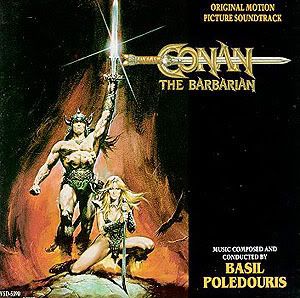 The musical score to "Conan the Barbarian" is truly one of the great achievements in fantasy/adventure film music. Basil Poledouris, who composed and conducted the music, brings a tremendous amount of passion and skill to his task. Equally passionate are the performances by the Orchestra and Chorus of Santa Cecilia and the Radio Symphony of Rome. This is big, bold, richly colored music with a lusty, savage vibe.
The musical score to "Conan the Barbarian" is truly one of the great achievements in fantasy/adventure film music. Basil Poledouris, who composed and conducted the music, brings a tremendous amount of passion and skill to his task. Equally passionate are the performances by the Orchestra and Chorus of Santa Cecilia and the Radio Symphony of Rome. This is big, bold, richly colored music with a lusty, savage vibe.01. Anvil Of Crom (02:34)
02. Riddle Of Steel / Riders Of Doom (05:36)
03. Gift Of Fury (03:50)
04. Wheel Of Pain (04:09)
05. Atlantean Sword (03:50)
06. Theology / Civilization (03:13)
07. Wifeing (Love Theme From Conan The Barbarian) (02:10)
08. The Leaving / The Search (05:59)
09. Mountain Of Power Procession (03:21)
10. The Tree Of Woe (03:31)
11. Recovery (02:11)
12. The Kitchen / The Orgy (06:30)
13. Funeral Pyre (04:29)
14. Battle Of The Mounds (04:52)
15. Death Of Rexor (05:34)
16. Orphans Of Doom / The Awakening (05:31)
Part 1 Part 2
Pass: mbmc (sorry for this mistake:)



















